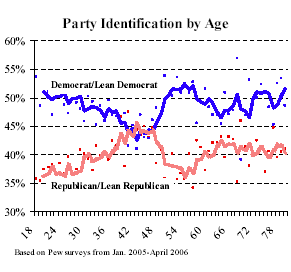From my mini-article invited by the American Journal of Sociology:
I first read about the age-period-cohort problem many years ago, but I didn’t think seriously about it until recently, when I saw some survey results showing party identification by age:
Americans in their forties are the most Republican group, a pattern that I would attribute to this group coming of political age during the presidencies of Jimmy Carter and Ronald Reagan. Older Americans might be more likely to associate the Republicans with Richard Nixon and Watergate, whereas younger voters associate the Democrats with Bill Clinton and the Republicans with George W. Bush. Thus can the difference in popularity of successive presidents propagate into systematic patterns of political attitudes by age.
But do I really have the evidence to make this claim? Implicitly I am following a model in which voters lock in their party identification early, perhaps between the ages of 15 and 25, and then stay with this (perhaps with small changes) throughout their lives. How could we test this model? . . .
I should warn you, though, I don’t have any answers (yet)!




